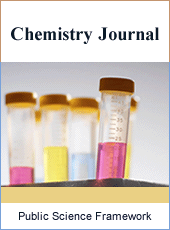Chemistry Journal
Articles Information
Chemistry Journal, Vol.1, No.2, Apr. 2015, Pub. Date: Apr. 2, 2015
Changes of the Quercetin Absorption Spectra in Dependence on Solvent
Pages: 31-34 Views: 5557 Downloads: 8187
[01]
Martina Bancirova, Palacky University, Department of Medical Chemistry and Biochemistry, Hnevotinska 3, 77515 Olomouc, Czech Republic.
The autooxidation of quercetin under laboratory conditions was studied by changes of the absorption spectra during seven hours after dilution. The influence of the primal solvent was observed. In case of quercetin dissolved in ethanol, there can be observed the decrease in λmax at 380 nm, in case of quercetin dissolved in methanol; there can be observed the decrease in λmax at 385 nm, in case of quercetin dissolved in DMSO, there can be observed the decrease in λmax at 390 nm. There is also the appearance of new peak at 330 nm for quercetin dissolved in all solvents.
Quercetin, Solvent, Spectrophotometry
[01]
Tan, W.-f., et al. 2003. Quercetin, a dietary-derived flavonoid, possesses antiangiogenic potential. European Journal of Pharmacology 459: 255-262.
[02]
Hertog, M. G., et al. 1992. Content of potentially anticarcinogenic flavonoids of 28 vegetables and 9 fruits commonly consumed in the Netherlands. Journal of Agricultural and Food Chemistry 40: 2379-2383.
[03]
Hertog, M. G., et al. 1993. Content of potentially anticarcinogenic flavonoids of tea infusions, wines, and fruit juices. Journal of Agricultural and Food Chemistry 41: 1242-1246.
[04]
Heim, K. E., et al. 2002. Flavonoid antioxidants: chemistry, metabolism and structure-activity relationships. Journal of Nutritional Biochemistry 13: 572-584.
[05]
Makris, D. P. and J. T. Rossiter 2002. An investigation on structural aspects influencing product formation in enzymic and chemical oxidation of quercetin and related flavonols. Food Chemistry 77: 177-185.
[06]
Sokolová, R., et al. 2011. The oxidation mechanism of the antioxidant quercetin in nonaqueous media. ElectrochimicaActa 56: 7421-7427.
[07]
Zhou, A., et al. 2007. Electrochemical degradation of quercetin: Isolation and structural elucidation of the degradation products. Electrochemistry Communications 9: 2246-2255.
[08]
Sokolová, R., et al. 2010. Oxidation pathways of natural dye hematoxylin in aqueous solution. Collection of Czechoslovak Chemical Communications 75: 1097-1114.
[09]
Ramešová, Š., et al. 2012. On the stability of the bioactive flavonoids quercetin and luteolin under oxygen-free conditions. Analytical and Bioanalytical Chemistry 402: 975-982.
[10]
Sokolová, R., et al. 2012. The oxidation of natural flavonoid quercetin. Chemical communications (Cambridge, England) 48: 3433.

ISSN Print: 2381-7674
ISSN Online: 2381-7682
Current Issue:
Vol. 6, Issue 1, March Submit a Manuscript Join Editorial Board Join Reviewer Team
ISSN Online: 2381-7682
Current Issue:
Vol. 6, Issue 1, March Submit a Manuscript Join Editorial Board Join Reviewer Team
| About This Journal |
| All Issues |
| Open Access |
| Indexing |
| Payment Information |
| Author Guidelines |
| Review Process |
| Publication Ethics |
| Editorial Board |
| Peer Reviewers |


